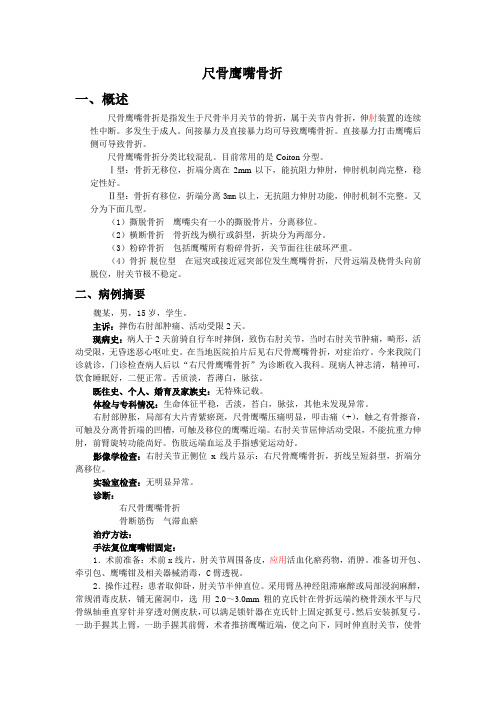尺骨鹰嘴骨折AO治疗原则
尺骨鹰嘴骨折完整版

间接暴力所致骨折 肌肉牵拉所致尺骨鹰嘴骨折
EXIT BA.CK NEXT
2.直接暴力所致骨折,多为 粉碎型,因骨膜及关节囊 保持完整,骨折无移位。
肱三头肌
3.多数尺骨鹰嘴骨折的骨折线
侵入关节面,属关节内骨折。
直接暴力 所致骨折
4.根据移位情况分为:无移位和 移位骨折;根据骨折线是否涉及关节面分为关节外
治疗:
手法整复(较容易)
问题: 1、固定 在非功能位(伸直) 对功能恢复有影响;
2、关节 面复位不易达解剖对 合(粉碎性骨折更明 显)。
手术治疗(近年趋向)
操作易,可达理
想对位,可早进入肘 部练功,关节功能恢 复快。
.ห้องสมุดไป่ตู้
㈠ 复位:复位时应“母求子”,即近端对远端。 注意复位前先抽出关节内积血再复位。
拇指抵于尺骨鹰嘴
推挤伸肘
EXIT BA.CK NEXT
㈡ 固定:复位后,尺骨 鹰嘴上端抱骨圈固定 肘关节于屈曲0~20° 位3周,再逐渐改为 屈肘90°1~2周。
复位前
EXIT BA.CK NEXT
复位后
㈢ 练功活动:
3周内只作手、腕关节屈伸活动,禁止肘关节活
动,第4周开始逐渐做肘部主动活动,严禁暴力被
动活动。
㈣药物治疗:
初期
活血化瘀 消肿止痛
中期 后期
接骨续筋
补气养血 补肝益肾 强筋壮骨
内服 外敷 内服
外敷 内服 外敷
活血止痛汤 消瘀止痛药膏 新伤续断汤 接骨续筋药膏 六味地黄丸
坚骨壮筋膏
EXIT BA.CK NEXT
(五)手术治疗
1、钢板内固定 2、钢丝张力带固定 3、鹰嘴钩外固定器外固定
骨折治疗的AO原则AO理念和基本原则课件

骨折治疗需要大量的医疗资源和人力投入,而医疗资源的紧张使得医生
需要在有限的时间内做出最佳的治疗决策,提高治疗效果和患者的康复
速度。
未来发展方向
个性化治疗
随着医疗技术的进步,骨折治疗的未来发展方向将更加注重个性化治疗。医生将根据患者 的具体情况和需求,制定个性化的治疗方案,提高治疗效果和患者的康复速度。
骨折治疗的ao原则ao 理念和基本原则课件
contents
目录
• AO原则与理念 • AO基本原则 • AO分型系统 • AO治疗策略与技巧 • AO原则的挑战与未来发展方向 • 案例分析与实践经验分享
01
AO原则与理念
AO原则的定义与起源
定义
AO原则是一种骨折治疗的理念和原则,强调通过解剖复位、 坚强固定和早期功能锻炼来促进骨折愈合和功能恢复。
坚强固定
使用内固定或外固定技术,对骨折部 位进行稳定固定,防止骨折移位和愈 合不良。
AO原则在骨折治疗中的应用
适应症
手术技巧
AO原则适用于各种类型的骨折,特别是关 节内骨折、骨干骨折和多发性骨折等复杂 骨折。
根据AO原则,医生需要熟练掌握手术技巧 ,包括切开复位、内固定植入、外固定架 应用等,以确保骨折的精确复位和固定。
起源
AO原则起源于20世纪50年代的欧洲,由德国创伤外科学会 前主席Muller和瑞士创伤外科学会前主席Schanz等医生共同 创立,旨在提高骨折治疗的疗效和患者的生活质量。
AO理念的核心内容
解剖复位
早期功能锻炼
通过手术等方法,将骨折断端精确复 位,恢复骨骼的解剖结构和功能。
在骨折愈合过程中,鼓励患者进行早 期功能锻炼,以促进血液循环、消除 肿胀、防止肌肉萎缩和关节僵硬。
尺骨鹰嘴骨折两种治疗方法的比较

尺骨鹰嘴骨折两种治疗方法的比较摘要目的:观察改良克氏针张力带和微型加压外固定器治疗尺骨鹰嘴骨折临床疗效。
方法:尺骨鹰嘴骨折患者36例,随机分为两组,即a组(改良克氏针张力带治疗尺骨鹰嘴骨折)、b组(微型加压外固定器治疗尺骨鹰嘴骨折)。
结果:a组骨折达解剖复位30例,b组近解剖学对位6例。
结论:改良针丝张力带固定是治疗尺骨鹰嘴骨折较为理想的方法。
微型加压外固定器治疗尺骨鹰嘴骨折,术后不需石膏外固定及二次手术,操作简便,适宜在基层医院开展及推广。
资料与方法1997~2007年收治尺骨鹰嘴骨折患者36例,随机分为两组,即a组(改良克氏针张力带治疗尺骨鹰嘴骨折)、b组(微型加压外固定器治疗尺骨鹰嘴骨折)。
a组男22例,女8例,年龄15~57岁,平均37.7岁;伤后至手术时间8小时内26例,24~48小时4例。
b组男4例,女2例;年龄30~54岁,右侧6例。
a组骨损伤情况:30例中,开放性骨折14例,陈旧性骨折1例,横形骨折18例,粉碎性骨折3例,均为分离移位,两骨折块分离0.8~3.0cm。
本组合并同侧肱骨干骨折1例。
b组骨折类型:横形骨折5例,粉碎性骨折1例。
a组手术方法:应用改良克氏针张力带治疗尺骨鹰嘴骨折。
本组30例均选用手术,臂丛麻醉,取肘后切口。
开放性骨折经彻底清创后行切口两端“s”延长,陈旧骨折作肱三头肌舌瓣切口,先解剖尺神经并牵开保护,在骨折远端距断面2~ 2.5cm的后1/3处由内向外用3.0mm钻头横行钻孔道,穿入直径1mm钢丝;骨折复位,再用直径 1.5mm克氏针1根从骨折近端鹰嘴后方向远端与尺骨纵轴呈15°左右钻入,针进入远折端约6~8cm,钢丝环形缠绕针尾拧紧,折弯针尾,剪除多余部分,活动肘关节,检查骨折复位及固定情况。
本组6例尺神经合并伤,根据伤情予以相应处理并前移。
3例肱骨干骨折,行切开复位内固定。
b组手术方法:在臂丛麻醉下,上臂中上段置气囊止血带,患肘置于胸前位,取肘后正中切口,始于鹰嘴顶点上方2cm,沿尺骨嵴向下延长4cm,暴露骨折断端,清除血块及血肿,将肘关节置于130°位,直视下使尺骨鹰嘴解剖学对位,巾钳固定。
张力带内固定治疗髌骨骨折和尺骨鹰嘴骨折

张力带内固定治疗髌骨骨折和尺骨鹰嘴骨折*导读:髌骨骨折和尺骨鹰嘴骨折是一种常见损伤,多由跌碰所致。
……髌骨骨折和尺骨鹰嘴骨折是一种常见损伤,多由跌碰所致。
在煤矿地区,髌骨骨折和尺骨鹰嘴骨折尤为多见。
这两种骨折均为关节内骨折,治疗上要求较高,手术方法亦多,正确选择手术方法是提高治疗效果的重要因素之一。
近年来,随着生物力学研究的进展,骨科应用生物力学原理的范围越来越广泛。
“AO”派率先应用张力带原理固定骨折,我国亦有报道。
我院于1990年5月以来,对83例髌骨粉碎性骨折和16例尺骨鹰嘴粉碎性骨折患者施行了张力带内固定术,现报告如下。
1 手术方法1.1 髌骨骨折选用腰麻,在膝关节前部做一略呈弧形的10cm长的横切口,切口两端位于髌骨中部水平,中部位于髌骨下极处。
以髌骨横形骨折为例。
显露骨折,复位满意后,于髌骨侧位中央部,正位将髌骨分为3等份,各穿入一枚克氏针,将针尾折弯。
穿出髌骨下缘的克氏针只保留3~5mm,多余部分剪除,用钢丝“8”字交叉绕在2枚克氏针上或分别用钢丝“8”交叉绕在克氏针上,进一步精确复位,伸直膝关节拧紧钢丝。
1.2 尺骨鹰嘴骨折选用臂丛麻醉,取肘后纵行切口。
显露骨折后精确复位。
于尺骨近端侧位中央,正位将尺骨鹰嘴分为3等份,在内侧与中间2等份的交界部及外侧与中间2等份的交界处,从鹰嘴近端进针各穿入一枚克氏针,于尺骨中上1/3处出针。
进针深度超过骨折线3~5mm,针尾折弯。
克氏针穿出部分保留3~5mm,用钢丝“8”字交叉绕在2枚克氏针上或用钢丝分别“8”字交叉绕在克氏针上,伸直肘关节拧紧钢丝。
对于粉碎性骨折,不论是髌骨骨折或尺骨鹰嘴骨折,克氏针的方向应尽量和骨折线垂直,视骨折情况可用3枚或4枚克氏针固定。
对于骨折块只有2块的患者,如果1枚克氏针可固定确切,可采用单枚克氏针固定。
对于各种情况,术者应视骨折程度和术中情况具体灵活掌握。
01-01-06尺骨鹰嘴骨折

尺骨鹰嘴骨折一、概述尺骨鹰嘴骨折是指发生于尺骨半月关节的骨折,属于关节内骨折,伸肘装置的连续性中断。
多发生于成人。
间接暴力及直接暴力均可导致鹰嘴骨折。
直接暴力打击鹰嘴后侧可导致骨折。
尺骨鹰嘴骨折分类比较混乱。
目前常用的是Coiton分型。
Ⅰ型:骨折无移位,折端分离在2mm以下,能抗阻力伸肘,伸肘机制尚完整,稳定性好。
Ⅱ型:骨折有移位,折端分离3mm以上,无抗阻力伸肘功能,伸肘机制不完整。
又分为下面几型。
(1)撕脱骨折鹰嘴尖有一小的撕脱骨片,分离移位。
(2)横断骨折骨折线为横行或斜型,折块分为两部分。
(3)粉碎骨折包括鹰嘴所有粉碎骨折,关节面往往破坏严重。
(4)骨折-脱位型在冠突或接近冠突部位发生鹰嘴骨折,尺骨远端及桡骨头向前脱位,肘关节极不稳定。
二、病例摘要魏某,男,15岁,学生。
主诉:摔伤右肘部肿痛、活动受限2天。
现病史:病人于2天前骑自行车时摔倒,致伤右肘关节,当时右肘关节肿痛,畸形,活动受限,无昏迷恶心呕吐史。
在当地医院拍片后见右尺骨鹰嘴骨折,对症治疗。
今来我院门诊就诊,门诊检查病人后以“右尺骨鹰嘴骨折”为诊断收入我科。
现病人神志清,精神可,饮食睡眠好,二便正常。
舌质淡,苔薄白,脉弦。
既往史、个人、婚育及家族史:无特殊记载。
体检与专科情况:生命体征平稳,舌淡,苔白,脉弦,其他未发现异常。
右肘部肿胀,局部有大片青紫瘀斑,尺骨鹰嘴压痛明显,叩击痛(+),触之有骨擦音,可触及分离骨折端的凹槽,可触及移位的鹰嘴近端。
右肘关节屈伸活动受限,不能抗重力伸肘,前臂旋转功能尚好。
伤肢远端血运及手指感觉运动好。
影像学检查:右肘关节正侧位x线片显示:右尺骨鹰嘴骨折,折线呈短斜型,折端分离移位。
实验室检查:无明显异常。
诊断:右尺骨鹰嘴骨折骨断筋伤气滞血瘀治疗方法:手法复位鹰嘴钳固定:1.术前准备:术前x线片,肘关节周围备皮,应用活血化瘀药物,消肿。
准备切开包、牵引包、鹰嘴钳及相关器械消毒,C臂透视。
2.操作过程:患者取仰卧,肘关节半伸直位。
骨科治疗的ao原则

1、AO的理念通过以下的治疗概念得以充分的表达:安全有效的切开复位,骨折内固定,辅以术后早期功能锻炼。
2、AO最基本的原则就是:在患者自身的环境之下对骨折进行适当的治疗。
3、由于关节骨折和骨干骨折具有非常不同的生物学需求,所以手术干预的时间及方式取决于周围软组织的损伤程度及患者的生理需求。
4、过去对任何骨折都追求绝对的坚强内固定,而现在的共识是坚强的内固定只适用于关节及相关骨折,而且只有在此操作不会进一步损伤血液供应及软组织的情况下才会施行。
5、骨干骨折通常会选择髓内钉,骨折会通过骨痂形成而愈合。
6、前臂骨干由于既拥有长骨的形态,又具有静态关节的功能,对其骨折的处理则需要特别的了考虑。
7、关节骨折需要解剖复位及绝对稳定性以促进关节软骨的愈合及使早期活动成为可能,这对于恢复良好功能是必须的。
8、适用于今日的AO原则:(1)通过骨折复位及固定重建解剖关系;(2)按照骨折的“个性”及损伤的需要使用固定或夹板重建稳定性;(3)使用细致操作及轻柔复位方法以保护软组织及骨的血供;(4)全身及患部的早期和安全的活动训练。
9、对于内固定来说并部需要强度最大或刚度最高的内固定物。
内固定不能永久的代替折断的骨骼,只能作为临时的支撑而已。
10、骨最主要的力学特性是它的刚度(应力下骨的变形很小)和强度(骨可承受很大的应力)。
但尽管骨的强度很大,但是轻度的变形即可令其折断。
11、骨折是单次活多次过载的结果。
12、骨折的力学特性主要包括骨连续性的丧失,导致病理性的异常活动以及功能性支持作用的丧失,最终造成疼痛。
13、创伤性骨连续性的破坏可造成骨髓腔内外血管的断裂,由此释放出的化学物质可刺激诱发骨的愈合过程;手术治疗的目的是引导和支持骨的愈合过程。
14、尽管骨折的产生是一个纯粹的力学过程,但可触发诸如骨吸收和骨(痂)形成等重要的生物学反应;这都依赖于血运的存在,下列因素都可能损伤骨折端的血运:(1)创伤事故:骨折块移位后骨内外膜血管的断裂以及骨膜的剥脱;(2)转运:一定要制动;(3)手术入路:(4)内固定物:(5)关节内压力的增高可影响干骺端部位的血运,尤其是年轻患者。
骨折治疗的AO原则(第一讲):AO理念和基本原则

AO治疗策略要求制定个性化的康复 计划,根据患者的具体情况和康复 进度,逐步调整康复方案,以达到 最佳的治疗效果。
THANKS
谢谢
早期活动
总结词
早期活动是指在骨折愈合过程中尽早进行关节活动和功能锻炼,以促进关节功能恢复和预防僵硬。
详细描述
早期活动有助于改善血液循环,促进骨折愈合和软组织的修复。同时,通过关节活动和功能锻炼,可 以预防关节僵硬和肌肉萎缩,提高患者的日常生活能力和生活质量。早期活动应根据具体情况而定, 在医生的指导下进行。
坚强固定
通过使用内固定器械,如 钢板、螺钉等,对骨折端 进行坚强固定,以维持骨 折端的稳定性和对位。
早期功能锻炼
在骨折愈合过程中,患者 应尽早进行功能锻炼,以 促进关节活动和肌肉力量 的恢复。
AO原则在骨折治疗中的重要性
提高骨折愈合率
遵循AO原则的骨折治疗能 够实现解剖复位和坚强固 定,从而促进骨折愈合, 提高愈合率。
C3型
03
关节内复杂骨折,合并干骺端骨折
04
CHAPTER
AO治疗策略
手术指征
严重骨折
对于严重的骨折,如开放性骨折、粉碎性骨折等,AO治 疗策略主张尽早进行手术复位和固定,以促进骨折愈合和 功能恢复。
关节内骨折
关节调通过手术实现关节面的精确复位,以减少术后并 发症和关节功能障碍。
03
CHAPTER
AO分型系统
A型:关节外骨折
A1型
简单骨折,无粉碎性
A2型
有部分关节面的简单骨折
A3型
关节面的复杂骨折,但无严重粉碎性
B型:骨干骨折
B1型
螺旋形或斜形骨折
B2型
弯曲、粉碎性干骺端骨折
【临床路径】尺骨鹰嘴骨折诊疗常规

尺骨鹰嘴骨折诊疗常规【概述】尺骨鹰嘴骨折为肘部常见骨折,可分为有移位和无移位二类。
移位的尺骨鹰嘴骨折又可分为撕脱、横断、斜形、粉碎等。
若骨片分离需做切开复位内固定,手术方法有克氏针张力带钢丝内固定术、螺钉内固定术、LCP钢板螺钉内固定术等。
【诊断标准】1、有外伤病史,局部肿胀、疼痛,活动受限,可触及骨檫音和异常活动。
2、X线片示存在骨折征象和移位。
【纳入标准】有移位的横断或斜形骨折。
【排除标准】1、粉碎性尺骨鹰嘴骨折,开放性尺骨鹰嘴骨折,陈旧性尺骨鹰嘴骨折,病理性尺骨鹰嘴骨折。
2、严重骨质疏松。
3、局部皮肤及软组织挫伤严重;或术区有明显感染灶者4、合并其它外伤或内科疾病。
5、小儿尺骨鹰嘴骨折(≤14岁)。
【治疗常规】1、手术(1)手术指征:有移位的横断或斜形骨折。
(2)麻醉方式:臂丛神经阻滞。
(3)术后换药拆线:术后第一天拍DR X线片,术后第1、3、5、10天各换一次药,术后第10-14天拆线,更换石膏。
2、药物(1)术前:术前0.5-2小时至术后3日给予抗生素预防感染。
(2)术后:应用活血化淤及促进骨折愈合药物。
3、检查(1)术前:血、尿、粪常规,肝功、肾功、凝血四项、电解质、血糖、血脂、全导心电图、乙肝五项、丙肝抗体、梅毒抗体、艾滋病抗体,胸部正位及骨折部正、侧位DR X线片。
(2)术中:C臂X光机透视。
(3)术后:血常规、乙肝五项、丙肝抗体、梅毒抗体、艾滋病抗体,骨折部位正、侧位DR X线片。
【出院标准】1、切口Ⅰ/甲愈合。
2、骨折对位对线良好,内固定物牢靠。
3、体温正常、血象正常。
【质量标准】1、平均住院日:17天。
2、疗效标准:治愈率≥99%,病死率<1%。
3、切口感染率<0.5%。
尺骨鹰嘴骨折临床路径编码:S52.003 疾病名称:尺骨鹰嘴骨折适用对象:尺骨鹰嘴骨折拟行:切开复位内固定术住院日期:年月日/出院日期:年月日预期住院天数17 天/实际住院天数:天预期术前住院天数:2 天/实际术前住院天数:天。
- 1、下载文档前请自行甄别文档内容的完整性,平台不提供额外的编辑、内容补充、找答案等附加服务。
- 2、"仅部分预览"的文档,不可在线预览部分如存在完整性等问题,可反馈申请退款(可完整预览的文档不适用该条件!)。
- 3、如文档侵犯您的权益,请联系客服反馈,我们会尽快为您处理(人工客服工作时间:9:00-18:30)。
Postoper ative treatmen t
Hidden trouble and complica tion
Clinical efficacy
Introduction
The olecranon is close to the skin and is prone to fracture under direct violence. Ulnar olecranon fracture caused by hyperextension and torsion is the most common type of elbow injury.
Thank for your listening!
Note:
The involution of radial head and humeral head must be carefully evaluated to identify whether there is displacement or instability. Simple transverse or oblique fractures are not necessarily stable because they can be associated with dislocation of the elbow or forearm.
II. Most patients have functional recovery of elbow joint mobility.
III. Despite the mild limitation of elbow extension, there is no obvious dysfunction.
3、Preoperative plan
Position and surgical approach
Reset technology and instruments
Selection of internal plants and principle of tension band
3、Preoperative plan—Position and surgical approach The posterior approach was used to cut the skin incision from the supracondylar fracture of the humerus to the distal end of the fracture 4~5cm. The incision can slightly bend to the radial side to protect the ulnar nerve and avoid contusion and laceration of the skin. Too large flap may cause difficulty in healing and should be avoided. Since splitting the elbow muscle fibers may result in loss of innervation, it is necessary to strip the elbow muscle close to the ulna and expose the elbow joint.
4、Surgical skills
• After flushing and clearing the joint cavity, the fragment should be repositioned, and the compressed joint surface must be fully raised to restore the anatomical structure. • For oblique fractures, in order to prevent displacement, one lag screw may be inserted perpendicular to the fracture line before tension band fixation. • For complex comminuted fractures, indirect reduction is preferable: 3.5mm LCP or remodeled proximal ulnar reconstruction plate is optional for the implant. The proximal screws should be placed in the direction of the pulp cavity and perpendicular to other screws to form an interlocking structure.
2、Treatment plan
Most olecranon fractures need open reduction and internal
fixation.
For cases with extended elbow devices intact and without displacement, non operative treatment can be chosen. In view of the eccentric traction of triceps tendon, the fixation of fracture needs to follow the tension band principle.
To allow early motion of the elbow, it is essential to achieve precise and stable anatomical reconstruction of the different ring structures that make up this anatomy
stainless steel wires (1 mm or 2 mm) were circumscribed. Oblique fracture should be fixed with 1 screws to achieve balanced pressure. For comminuted fractures and fractures involving the distal coronoid process, the posterior plate (1/3 tubular plate, reconstruction plate or 3.5mm LCP) is preferable, and the shaping 3.5mm olecranon anatomical LCP is also preferable.
Olecranon fracture
Shandong Provincial Hospital
Introduction
Fracture and Soft tissue assessm ent
Treatme nt plan
Preopera tive plan
Surgical skills and points
6、Hidden trouble and complication
• Kirschner wire withdrew and ejection skin. • Pain • Fracture nonunion, rare
7、Clinical efficacy
I. Most ulnar olecranon fractures can be healed by first intention.
5、Postoperative treatment
• In the first 24-48 hours after the operation, the use of rear brace can increase patient comfort, but it is not necessary. If the fracture ends are stable, the patient can safely exercise the affected limb. • A few days after the operation, active function training can be carried out under auxiliary. • Within 1 week after operation, active functional exercise should be closely monitored to avoid contracture of the elbow joint.
3、Preoperative plan—Selection of internal plants and principle of tension band
Simple transverse or oblique fractures, two Kirschner wires (1.8
mm or 1.6 mm) were used as internal splints and one or two
1、Fracture and soft tissue assessment
Olecranon fractures are typically transverse and oblique type B1 fractures in which elbow extensors are destroyed by bending stresses acting on the distal humerus. With the increase of external force, the central part of olecranon articular surface may be comminuted and compressed, and even the avulsion fracture of coronal process may occur. The patient complained of pain and unable to move the elbow joint. The local skin presented swelling, congestion or contusion.
